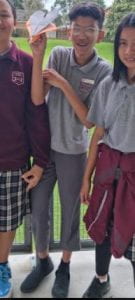LI: To design and make a paper plane that will fly the furthest.
For this week’s maths, LS2 has been learning about measurement and distances by building paper planes to understand the maths behind it. After making them, we then analysed our data of the paper air planes we flew. Our group designed multiple planes to verify which of the planes flew the best. The plane that went the furthest was the plane I made. Lastly we versed group by group and measured the flight distance accurately.

